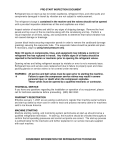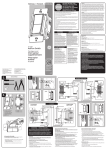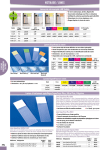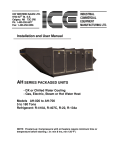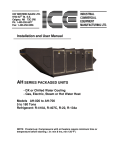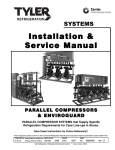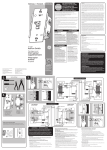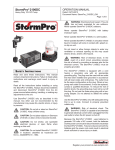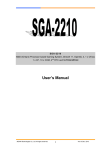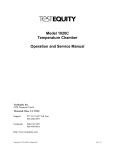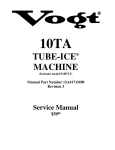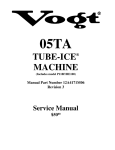Download Arctic-Temp®
Transcript
Arctic-Temp® Index: Principles of Operation.........................................................................................................Page 2 Model Specifications Sheet 5200LSM-2 (R404A & R22 comparative)...........................Page 3 Model Specifications Sheet 1000LSM (R404A & R22 comparative)...............................Page 4 Cycle Timer Functions..........................................................................................................Page 5 Positive Harvest Control.......................................................................................................Page 6 Fan Cycling Control...............................................................................................................Page 6 Dual Pressure Control...........................................................................................................Page 7 High Pressure Control...........................................................................................................Page 7 Low Pressure Control w/ Time Delay..................................................................................Page 8 Copeland Sentronic Oil Pressure Control..........................................................................Page 8 Core Sense Protection...........................................................................................................Page 9 Electronic Thermostat...........................................................................................................Page 9 Hot Gas Solenoid Valves on R404-A.................................................................................Page 10 Thermostatic Expansion Valves.........................................................................................Page 10 Mechanical Bin Control......................................................................................................Page 11 5200LSM-2 By-Pass and Isolation Loop for Low Ambient Controls............................Page 12 5200LSM-2 By-Pass and Isolation Loop for Low Ambient Controls Overview..........Page 13 1000LSM By-Pass and Isolation Loop for Low Ambient Controls...............................Page 14 1000LSM By-Pass and Isolation Loop for Low Ambient Controls Overview..............Page 15 Obsolete Pressure Regulating Valve - prior to by-pass loop..........................................Page 16 Rev 01/13 1 Arctic-Temp® Service Manual Principles of Operation The Arctic-Temp line of ice making machines from Holiday Ice, Inc., combines state-of-theart technology and efficiency with a reputation for quality and reliability developed over four decades of manufacturing. In the Arctic-Temp ice maker, ice is produced on vertically suspended, double-walled cylindrical evaporators. Chilled water is continually recirculated over both the inner and outer surfaces of the evaporator as refrigerant passes through the annular space between the two ice making surfaces. This process utilizes 100% of the evaporator surface and provides fast production with maximum efficiency of heat exchange. Ice making water is recirculated by pump from the stainless steel sump, where proper water level is maintained by a float valve. Water flows onto both the inner and outer evaporator surfaces by simple tubed water distributors. The freezing period is determined by a repeating cycle timer. At completion of the freeze cycle, hot gas from the compressor is introduced into the annular space. The introduction of hot gas “breaks the ice bond” from the evaporator surface, releasing the concentric cylinders of ice which fall by gravity into the ice crusher assembly. Here, the curved ice is cracked into irregular shapes and sizes. The rotation of the ice crusher delivers the ice across the grid and discharges it into the storage bin or bunker. A bin control stops the ice maker when the storage bin becomes full. The Arctic-Temp ice maker consists of four interrelated subsystems as follows: Refrigeration System The Arctic-Temp refrigeration system offers the ultimate in simplicity. The basic refrigeration system includes a non circulated Arctic-Temp evaporator and a dependable Copeland compressor. The Arctic-Temp refrigeration system is readily maintained with standard service tools and procedures and differs from a standard refrigeration system only in its simplicity. Refrigerant Condensing System The Arctic-Temp ice maker employs one of three methods of condensing: the dependable Copeland condensing unit, the Copeland Discus compressor with a matched condensing coil, or a Copeland Discus water-cooled condensing unit. All three condensing methods produce adequate capacity. A fan cycling control or water regulating valve maintains head pressure. Process Water System Ice making water is recirculated by centrifugal pump from the stainless steel sump, which utilizes a float valve to maintain the proper water level. Water flows onto both the inner and outer evaporator surfaces by simple tubed water distributors that require no maintenance other than occasional cleaning. Ice Handling System At completion of the freeze cycle, hot gas from the compressor is introduced into the cylinder. Gravity forces the ice to slip from the evaporator surfaces into the ice crusher assembly, where the curved ice is cracked into irregular shapes and sizes, delivered across the grid, and discharged into the storage bin or bunker. The Arctic-Temp ice maker presents no peculiar, complex, or out-of-the-ordinary hookups in any of its subsystems. Most replacement parts are readily available at local supply houses. Rev 01/13 2 ARCTIC-TEMP7 ICE MAKER MODEL 5200LSM MODEL SPECIFICATIONS SUPPLIED WITH LARKIN CONDENSING UNIT R-404A R-22 ELECTRICAL Volts/Phase/Hertz 208/230-3-60 208/230-3-60 45 45 48.7 48.7 70 70 7.5 HP 7.5 HP 187-253 187-253 Nameplate Rating (Amperes) 31.5 31.5 Locked Rotor Rating (Amperes) 161 161 Refrigerant Oil POE 3GS Refrigerant Charge 25 LBS 25 LBS R-404A R-22 Total F.L.A. Rating, Machine and Compressor Minimum Circuit Ampacity Maximum Overcurrent Protection COMPRESSOR Compressor (Copelametic7 Discus) Voltage Range (208/230) CONTROL SETTING APPROXIMATE *FAN SWITCH PRIMARY P70AA-118 ON /280 OFF/245 ON /235 OFF/205 PSIG *FIXED DIFFERENTIAL OF 30 PSIG - NOMINAL HIGH PRESSURE P70DA-1 415 345 PSIG LOW PRESSURE P29NC-3 W/ TIME DELAY 25 10 PSIG OIL PRESSURE CONTROL (DIFFERENTIAL) 9 MINIMUM SUCTION PRESSURE (AT HARVEST) 29 17 PSIG 82 65 PSIG POSITIVE HARVEST CONTROL REVERSE ACTING L.P. (OPENS ON RISE) 9 MINIMUM IF YOU HAVE ANY QUESTIONS REGARDING THE INSTALLATION AND OPERATION OF THIS MACHINE, PLEASE CALL FOR TECHNICAL ADVISE BEFORE PROCEEDING. (800) 362-3243 OR (407) 831-2077 Note: Crankcase heaters are installed on Arctic-Temp ice makers. Heater leads are connected to the L1/L2 position of the line contactor. CRANKCASE HEATER SHOULD BE ENERGIZED FOR TWO HOURS PRIOR TO STARTING THE MACHINE. Manufactured by HOLIDAY ICE, INC., Longwood, FL 32750 Specifications and design subject to change without notice. Arctic-Temp7 is a registered trademark of Holiday Ice, Inc. 8 2009 Jan. 2010 – RRA Saved as: 5200 Comparative R-404A & R-22 - 2010 Rev 01/13 3 ARCTIC-TEMP7 ICE MAKER MODEL SPECIFICATIONS MODEL 1000LSM SUPPLIED WITH LARKIN CONDENSING UNIT R-404A R-22 ELECTRICAL Volts/Phase/Hertz 208/230-3-60 208/230-3-60 Total F.L.A. Rating, Machine and Compressor 56.7 56.7 Minimum Circuit Ampacity 66.3 66.3 95 95 10 HP 10 HP 187-253 187-253 Nameplate Rating (Amperes) 42 42 Locked Rotor Rating (Amperes) 215 215 Refrigerant Oil POE 3GS Refrigerant Charge 35 LBS 35 LBS CONTROL SETTING APPROXIMATE R-404A R-22 Maximum Overcurrent Protection COMPRESSOR Compressor (Copelametic7 Discus) Voltage Range (208/230) *FAN SWITCH PRIMARY P70AA-118 ON /280 OFF/245 ON /235 OFF/205 PSIG *FAN SWITCH SECONDARY P70AA-118 ON /295 ON /250 OFF/220 PSIG HIGH PRESSURE P70DA-1 OFF/263 415 LOW PRESSURE P29NC-3 W/ TIME DELAY 25 345 PSIG 10 PSIG OIL PRESSURE CONTROL (DIFFERENTIAL) 9 MINIMUM SUCTION PRESSURE (AT HARVEST) 31 20 PSIG 82 65 PSIG POSITIVE HARVEST CONTROL REVERSE ACTING L.P. (OPENS ON RISE) 9 MINIMUM IF YOU HAVE ANY QUESTIONS REGARDING THE INSTALLATION AND OPERATION OF THIS MACHINE, PLEASE CALL FOR TECHNICAL ADVISE BEFORE PROCEEDING. (800) 362-3243 OR (407) 831-2077 Note: Crankcase heaters are installed on Arctic-Temp ice makers. Heater leads are connected to the L1/L2 position of the line contactor. CRANKCASE HEATER SHOULD BE ENERGIZED FOR TWO HOURS PRIOR TO STARTING THE MACHINE. Manufactured by HOLIDAY ICE, INC., Longwood, FL 32750 Specifications and design subject to change without notice. Arctic-Temp7 is a registered trademark of Holiday Ice, Inc. 8 2009 Jan. 2010 – RRA Saved as: 1000 Comparative R-404 & R-22 Rev 01/13 4 CYCLE TIMER FUNCTIONS Cycle Timer Arctic-Temp ice makers utilize a repeating cycle timer with a single cam to control the freeze and harvest cycles. Depending upon the machine, the cam allows for a total cycle of 6 or 8 minutes. Freeze phase is 90% and harvest phase is 10% of the total time. FREEZE CYCLE Freeze Cycle Timer Bin Control Lockout Rotating Rotating Cam Cam C Bin Control Lockout Micro Switch Micro-switch 0 1. 2. 3. 4. 10 20 NO NC 30 50 % NC NO Freezing time is approximately 90% of the total eight (8) minute cycle and controlled by a repeating cycle timer with a single cam. Compressor is running. Recirculating water pump is running. Hot gas solenoid(s) are/is closed. Ice crusher motor is off. When the timer has reached the end of the freeze cycle, the roller on the micro switch will enter the detent position of the cam on the primary micro switch and initiate the harvest cycle. C Primary Primary Micro-switch Micro Switch Harvest Cycle Timer HARVEST CYCLE Bin Control Lockout Micro Switch Bin Control Lockout Rotating Cam Rotating Cam C Micro-switch NO NC 20 30 % 50 0 10 NC NO C Primary Primary Micro Switch Micro-switch Harvest time is approximately 10% of the total time cycle. 1. 2. 3. 4. Compressor is running. Recirculating water pump is stopped. Hot gas solenoid(s) are/is open. Ice crusher motor is on. At the start of this cycle, the positive harvest control (PHC) pressure switch and its associated relay/pilot light will operate and hold the timer motor out of the electric circuit until the suction pressure reaches 82-90 PSIG (R404-A) (depending on the specific machine model) at which time the ice will start to drop and enter the crusher. All ice should be off the evaporators and through the crusher within 10-15 seconds. The harvest cycle will continue for another 20-30 seconds period which is called overrun. At completion of overrun, the freeze cycle is initiated. Note: When red pilot light is on, timer is stopped. BIN LOCKOUT Bin Lockout Timer Bin Control Lockout Micro Switch Rotating Cam C Bin Control Lockout Micro-switch Rotating Cam 30 10 % 20 50 NO NC Low ambient thermostats, when activated, will shut the machine down with this lock-out. 0 NC NO Bin thermostats, mechanical bin controls, and remote OFF/ ON switches may be activated at any time during the freeze and harvest cycles. Machine operation will continue upon opening any of these controls, and machine shutdown will be delayed until the roller on the bin control lockout micro switch is in the detent position of the cam. C Primary PrimarySwitch Micro Micro-switch Note: Most cycle timer problems are attributable to failed micro switches or roller guides that are not centered on the edge of the cam. Rev 01/13 5 MACHINE CONTROLS POSITIVE HARVEST CONTROL The positive harvest is controlled with a reverse acting low pressure control, switching relay, and red pilot light. This control works in conjunction with the timer to ensure hot gas is provided to the ice making evaporators to assist harvest in lower ambient temperatures or over condensing cause by excessive wind on the coil. LBS. PRES. CUT CUT PENN OUT IN 100 90 80 70 60 50 40 30 20 10 PENN P70CA-1 As the suction pressure falls on the low pressure side to approximately 40 PSIG for an R-404A system, the low pressure control closes. When the machine enters harvest, the low pressure control and relay de-energize the timer motor allowing for additional harvest time until the suction pressure reaches 82 PSIG (R404-A). At 82 PSIG, the relay is de-energized allowing the normally closed contacts to restart the timer motor in its normal operation. A LL- R A N G E The period of time required for the pressure switch to reach cutout PSIG varies with ambient temperature. Delay is minimal in warmer ambient temperatures. The pilot light is illuminated upon entry of harvest and will remain on until resetting of the control occurs at approximately 82 PSIG. NOTE 1)When the red pilot light is illuminated, the timer motor is locked out of the circuit and timer rotation is stopped. Low ambient conditions that cause the machine to continue to operate in harvest may result in compressor failure. NOTE 2)Condenser fans must be off during the harvest cycle to avoid freeze-ups and other control failure trips. FAN CYCLING CONTROL PRES. LBS. 200 150 100 50 35 100 200 300 400 DIFF. CUT IN CUT OUT IS CUT IN LESS DIFFERENTIAL CLOSES ON RISE OF PRESSURE PENN AL L -RANGE Settings Cut In Cut Out R-404A 40 PSIG 82 PSIG R-22 40 PSIG 65 PSIG PENN P70AA-118 Penn fan cycling controls are used to regulate head pressure by cycling the condenser fans motors. The switch is used to cycle the fan motors on and off at a specific setting. The Model 1000LSM operates with dual fan cycling controls that are staged. The Model 5200AR operates with a single fan control that operates both fans on the same cycling sequence. NOTE Condenser fans that are operating during the harvest cycle is a clear indication that the fan controls are set incorrectly. Rev 01/13 6 MACHINE CONTROLS DUAL PRESSURE CONTROL (Manual Reset) LBS. PRES. HIGH PRES. LBS. / SQ. IN PENN A LL-R A N GE OUT OUT IN PUSH TO RESET CUT CUT CUT 100 90 80 70 60 50 40 30 20 10 500 400 300 200 100 PENN P70NA-1 The Model 5200AR uses a high-low pressure switch is a single-pole, dual function switch. It is located on the condensing unit and protects the machine from possible damage due to abnormal pressures during operation. This control employs a SINGLE MANUAL RESET both high and low pressure trips. The high pressure side is set to open in the event excessive head pressure is reached. The low pressure side is set to open in the event excessive low pressure is reached. The disadvantage of this control is that the condition(s) that cause a “trip” can’t be immediately identified as high pressure or low pressure. However, most trips are attributable to the low pressure side. In addition, nuisance trips will result from low ambient conditions which causes efficient condensing and results in lower discharge and suction pressures. The low head pressure will not force enough refrigerant through the expansion valves to elevate the suction pressure. As a result, a “trip” will occur when the safety point cut-out on the low side is exceeded. Common low pressure trips are attributable to freeze-ups, low ambient conditions (failure to build head pressure), insufficient refrigerant charge, loss of water supply, and restricted water distribution due to mineral deposits. High Pressure The high pressure side is set to open in the event excessive head pressure is reached. This can occur if the condenser coil is dirty or blocked, a fan motor fails, or a control fails. Low Pressure The low pressure side is set to open in the event excessive low pressure is reached. This may occur if the machine has insufficient refrigerant charge, a loss of water to the evaporator surfaces, or a freeze-up which allows ice to remain on the evaporator surfaces. Control settings for cut-in and cut-out vary according to machine model. Please refer to Model Specifications sheet for correct control settings. HIGH PRESSURE CONTROL (Manual Reset) LBS/SQ. IN Rev 01/13 OUT IN 500 450 400 350 300 250 200 150 100 50 CUT CUT HIGH PRES. PENN PUSH TO RESET PENN P70DA-1 The Model 1000LSM and the model 5200LSM-2 use a stand-alone high pressure switch that provides the same function and operation of the high safety operation control identified above. A trip of this switch easily identifies that the condition that caused the trip was high pressure. AL L -RANG E 7 MACHINE CONTROLS LOW PRESSURE CONTROL W/ TIME DELAY (Manual Reset) The Model 1000LSM and the model 5200LSM-2 use this control which aids in low ambient starting conditions by providing a 60 second time delay to avoid low pressure trips when starting in cold weather. In low ambient conditions, the head pressure will not force enough refrigerant through the expansion valves to elevate the suction pressure. As a result, a control trip occurs because the safety point cut-out on the low side is exceeded. The time delay on this control will aid in the reduction of “nuisance” trips by providing the machine 60 additional seconds to build the necessary operating pressures above the set point. PENN OUT IN 100 90 80 70 60 50 40 30 20 10 CUT CUT LBS. PRES. PENN P29NC-3 PUSH TO RESET This control must be set and checked with a volt meter connected to switch terminals # 1 & 2 on the control. As the suction pressure drops, the meter reading will drop to zero volts at the set point. The delay will then be activated allowing the machine to run for and additional 60 seconds. If the suction pressure remains below the set point for more than 60 seconds the machine will shut down. NOTE: The intended benefit of this control is often negated by the failure to set this control correctly. COPELAND SENTRONIC OIL PRESSURE CONTROL-Manual Reset SENTRONIC Provided as standard equipment. TM OIL PRESSURE SENSING SYSTEM LIGHT INDICATION Green - Good Oil Pressure Red - Low Oil Pressure Orange - Self Check Mode None - No Module Power PUSH TO RESET 085-0172-04 The compressor is protected by a Copeland Sentronic Oil Pressure Control. This electronic unit consists of a manual reset control with a time delay and utilizes a sending unit attached to the oil pump to monitor oil pressure electronically. If the net oil pressure (net oil pressure is pump pressure minus the suction pressure) falls between the differential setting of 9 PSIG, the compressor will continue to run for 120 seconds attempting to build the required oil pressure. If the differential pressure has not been achieved within the delay period, the switch contact will open and stop the compressor. Oil Pressure Control “trips” can be caused by the following conditions: a) b) c) d) e) Excessive refrigerant in crankcase from overcharging or flood back. Sensor blocked with carbon or other debris in the screen. Crankcase heater is inoperative or power has been turned off. TXVs are maladjusted. Sentronic Control and/or sensor inoperative or defective. NOTE: Models 400/750/5200/1000 are equipped with a Motor Overload Protection Device (Klixon) that opens in the event compressor temperature or amperage reaches an extreme that could damage the compressor. The device automatically reset after the compressor has cooled. If the Klixon opens in order to protect the compressor motor, the oil pressure control will trip 60 seconds later because the compressor is not running. Therefore, the operator will assume the machine was off on oil pressure when, in fact, it was off on the Motor Overload. WARNING: If the machine is off on the Oil Pressure Control due to an oil problem, or as a result of the Motor Overload Protection Device, the control cycle timer and other components will continue to function although the compressor is off. The machine or any of its components, INCLUDING THE ICE CRUSHER ASSEMBLY, can start without warning and cause serious personal injury. Rev 01/13 8 MACHINE CONTROLS CORESENSE PROTECTION CoreSense TM The Copeland Discus compressors have a new protection system called Core Sense Protection. It replaces the Sentronic Oil Protection control and the Kriwan motor overload module. It incorporates oil pressure failure and motor overload protection in one unit. Protection for Copeland Discus Compressors ® Status Codes Flashes Condition GREEN - Power On 1 Oil Pressure GREEN - Warning 2 Motor Protection Trip YELLOW - Trip 3 Discharge Temperature 4 Current Sensor Fault 5 Communication Error RED - Lockout CONTROL # If the oil pressure drops below nine pounds for 120 seconds, the Core Sense will shut down and lock-out the compressor. In an overload condition, the internal overload will open and stop the compressor until it cools down, and then cycle on the overload. The oil pressure feature will not trip while the compressor is off by the overload. RESET In the cover are indicator lights for the status codes. If a problem exists, the lights will flash, indicating the area of the problem. Oil Pressure Control “trips” can be caused by the following conditions: a) b) c) d) e) Excessive refrigerant in crankcase from overcharging or flood back. Sensor blocked with carbon or other debris in the screen. Crankcase heater is inoperative or power has been turned off. TXVs are maladjusted. Sentronic Control and/or sensor inoperative or defective. NOTE: Models 400/750/5200/1000 are equipped with a Motor Overload Protection Device (Klixon) that opens in the event compressor temperature or amperage reaches an extreme that could damage the compressor. The device automatically reset after the compressor has cooled. If the Klixon opens in order to protect the compressor motor, the oil pressure control will trip 60 seconds later because the compressor is not running. Therefore, the operator will assume the machine was off on oil pressure when, in fact, it was off on the Motor Overload. WARNING: If the machine is off on the Oil Pressure Control due to an oil problem, or as a result of the Motor Overload Protection Device, the control cycle timer and other components will continue to function although the compressor is off. The machine or any of its components, INCLUDING THE ICE CRUSHER ASSEMBLY, can start without warning and cause serious personal injury. ELECTRONIC THERMOSTAT RANCO ETC 111-000-000 This control is provided as an optional feature for machines located outdoors in periods of low ambient weather. This control may be used in conjunction with other low ambient devices and controls to ensure harvest and uninterrupted operation at temperatures less than 50 degrees Fahrenheit. The factory set point is 50 degrees Fahrenheit with a 5 degree differential which will allow the machine to operate at temperatures above 45 degrees Fahrenheit. When the menu scrolls up, set the thermostat to operate in the H-1 mode. SET RANCO ELECTRONIC TEMPERATURE CONTROL When the thermostat is activated and the machine is shut down, the amber light on the bin control will be illuminated. Please note that the amber light also may indicate a full bin of ice and the mechanical bin control is satisfied. Note: Sensor Bulb should be threaded through grommet and secured by the clamp on the outside of the machine frame. When this control has the machine shut down at the set point, full bin will be indicated by the amber light on the mechanical bin control. The timer will be in the Lock-Out Detent. Rev 01/13 9 MACHINE CONTROLS HOT GAS SOLENOID VALVES ON R-404A Arctic-Temp Ice Makers are defrosted with Hot Gas Solenoid Valves. One solenoid valve and one expansion valve control two evaporators. These solenoids have been used continually for over 20 years without any significant problems or complaints. Disc Assembly IN Primary Port .035 OUT Secondary Port .040 / #60 drill With the introduction of R-404A and its known deficiency for oil return and velocity, some problems have occurred. A small number of new machines have developed “sticking” in the solenoid valves on start up. The condition involves the disc opening and “sticking” in the open position. The pressures above and below the disc control the disc operation. It is believed that the lack of oil in R-404A systems has contributed to this problem by not allowing the disc to reseat itself after harvest. Holiday Ice has discovered that oiling the internal parts of solenoid valves during assembly alleviates the majority of problems in start-up and field operations. The manufacturer, Sporlan Valve Company has denied any knowledge of a “sticking” problem. However, they have issued field directives regarding the possibility of Residual Magnetism in the plunger assembly and shipped these valves with brass washer to “break” the residual magnetism for over a year. That theory has now been discounted and we believe the issue is related to lack of oil and higher operating pressures. Sporlan is now experimenting with a new disc assembly that adds a secondary port to provide more above the disc pressure to provide for positive closing. We are now testing the new discs and have a limited number available for field replacement when required. THERMOSTATIC EXPANSION VALVES ADJUSTING TXV: Ice should form on the evaporator tubes no higher than approximately two inches from the top of the evaporator plates. Freezing too high on the evaporator could cause ice to freeze around the mounting flange and not release resulting in a freeze-up. Low ambient situations will affect the capacity and produce thicker ice and possibly freezing over the evaporator plates resulting in a freeze up. Out Capillary Bulb on Suction Line Power Head Adjustment Stem Close TXV - Clockwise (freeze lower on tubes) Remove TXV cap Expansion Valve inlet screen / strainer can be accessed by removing nut. In While facing the adjustment stem, adjust as follows: 1. Remove TXV cap. 2. Close TXV: Turn stem clockwise to freeze lower on the tubes (turning in) 3. Open TXV: Turn stem counterclockwise to freeze higher on the tube. (backing out). 4. Note: Any adjustment to the TXV should be ¼ turn or less at a time. The machine should be observed for several minutes before making further changes. TXV STRAINER: The strainer should be checked before making any adjustment to the valve. The TXV valves are preset at the factory. However, ash or debris in the system could block the strainer and cause improper flow. This condition will most likely occur in a new machine that is remotely installed in the field. Multiple cleanings may be required if erratic freezing occurs. Note: The machine must be pumped down prior to opening the strainers and should be performed by a qualified refrigeration technician. Rev 01/13 10 MACHINE CONTROLS MECHANICAL BIN CONTROL A mechanical flapper device is used to terminate ice production when the storage bin or bunker is full. It is recommended for use in refrigerated, freezer, and other applications that would adversely affect the use of a thermostat type control. This control will allow the ice maker to run until the flapper is held in the down position by accumulated ice. Delivery A secondary bin delay micro switch is used as a lockout feature. See the Bin Lockout illustration in the Cycle Timer Functions Narrative. chute The Mechanical Bin Control switching relay and low voltage transformer is located on a mounting rail directly under the main control box in the evaporator section. When the amber light is illuminated on the Mechanical Bin Control box, the machine is OFF on FULL BIN. 1. Mechanical Bin Control Flapper Assembly in stalled on ice delivery chute. 2. Mechanical Bin Flapper Assembly installed on ice delivery chute. 3. Mechanical Bin Flapper Assembly switch positions. Evaporator Housing Wire Mechanical Bin Flapper Mechanism Top view delivery chute Delivery chute paddle positions Ice non-harvest position: Switch Open Ice harvest position: Switch Closed Back side of Back View delivery chute 2 1/2” Ice Amber light is on indicating Drill two 3/16” holes 1/2” machine is off on full bin Rev 01/13 11 HOLIDAY ICE, INC 5200LSM BY-PASS & ISOLATION LOOP FOR LOW AMBIENT CONTROLS 1) LOW AMBIENT OPERATION (WINTER SEASON): a) Turn machine switch to the OFF position. b) CLOSE BALL VALVE IN DISCHARGE LINE. c) OPEN 2) BALL VALVES IN BY-PASS LINE. d) Turn machine switch to the ON position. RED color code BLUE color code NOTE: Acorn nut adjustment must be in the AUTO position in order for the Pressure Regulating valve to operate. 2) HIGH AMBIENT OPERATION (SUMMER SEASON): a) Turn machine switch to the OFF position. b) OPEN BALL VALVE IN DISCHARGE LINE. RED color code c) CLOSE 2) BALL VALVES IN BY-PASS LINE. BLUE color code d) Turn machine switch to the ON position. NOTE: All retrofitted and new machines with By-Pass Loops and 1 1/8 Pressure regulating valves are shipped with the balls valves set for the HIGH AMBIENT POSITION. When switching to LOW AMBIENT POSITION, please note that the PRV control is preset to modulate at 225 PSIG (R-404A) and the Acorn nut is in the AUTO position. No adjustment to the Pressure Regulating Valve is required. Call 407-831-2077 for technical support regarding this device. Rev 01/13 12 MODEL 5200LSM-2 BY-PASS & ISOLATION LOOP FOR LOW AMBIENT CONTROLS OVERVIEW Machines equipped with Low Ambient Controls operating in extremely high ambient conditions can produce “spikes” in head pressure on start-up resulting in nuisance highpressure trips. Although the PRV has an AUTO and OPEN position, it is believed that this control is not adjusted for summer and winter operation. Therefore, the machine will produce excessive head pressure when starting in high ambient conditions when the PRV valve is engaged in the AUTO POSITION. The addition of a By-Pass and Isolation Loop allows the Low Ambient Device to be completely isolated from the refrigeration system while operating in HIGH AMBIENT CONDITIONS with 3) manually operated ball valves. An additional benefit is provided if the PRV fails due to a worn cartridge or ruptured internal parts, it fails in the closed position. The addition of the By-Pass Loop will allow the machine to return to operation by changing ball valve positions without immediate service and repair. “AUTO” SETTING” The Pressure Regulating Valve must be set to the AUTO position in order to modulate and maintain head pressure for defrosting in Low Ambient Conditions. The Adjustment Sequence is as follows: Remove the “acorn” nut from the side of the valve that is marked “AUTO” and “OPEN”. Arrows mark the direction to adjust. With a slotted screwdriver, turn the adjustment clockwise (CW) until it stops to set the control on AUTO (automatic). Replace the acorn nut. The machine must be turned off during adjustments to avoid the hot discharge line and rotating fan. “SETTING THE PRV VALVE” The Pressure Regulating valve is factory set to modulate and maintain head pressure of 225 PSIG on R-404A during the harvest cycle (185 PSIG on R-22). If it becomes necessary to adjust the pressure setting, the window of adjustment is approximately 20 seconds after entering the harvest cycle. When the machine enters harvest and the pressures equalize, begin turning the adjustment stem until the discharge pressure reaches 225 PSIG. Turn the adjusting stem clockwise (CW) to raises the pressure and counter clockwise (CCW) to lower the pressure. Adjustment pressures must be read at the inlet port fitting of the Pressure Regulating Valve. 5200LSM BY-PASS LOOP ADVISEMENT/ 2011 Rev 01/13 13 HOLIDAY ICE, INC 1000LSM BY-PASS & ISOLATION LOOP FOR LOW AMBIENT CONTROLS 1) LOW AMBIENT OPERATION (WINTER SEASON): a) Turn machine switch to the OFF position. b) CLOSE BALL VALVE IN DISCHARGE LINE. c) OPEN 2) BALL VALVES IN BY-PASS LINE. d) Turn machine switch to the ON position. RED color code BLUE color code NOTE: Acorn nut adjustment must be in the AUTO position in order for the Pressure Regulating valve to operate. 2) HIGH AMBIENT OPERATION (SUMMER SEASON): a) Turn machine switch to the OFF position. b) OPEN BALL VALVE IN DISCHARGE LINE. RED color code c) CLOSE 2) BALL VALVES IN BY-PASS LINE. BLUE color code d) Turn machine switch to the ON position. NOTE: All retrofitted and new machines with By-Pass Loops and 1 1/8 Pressure regulating valves are shipped with the balls valves set for the HIGH AMBIENT POSITION. When switching to LOW AMBIENT POSITION, please note that the PRV control is preset to modulate at 225 PSIG (R-404A) and the Acorn nut is in the AUTO position. No adjustment to the Pressure Regulating Valve is required. Call 407-831-2077 for technical support regarding this device. Rev 01/13 14 MODEL 1000LSM BY-PASS & ISOLATION LOOP FOR LOW AMBIENT CONTROLS OVERVIEW Machines equipped with Low Ambient Controls operating in extremely high ambient conditions can produce “spikes” in head pressure on start-up resulting in nuisance highpressure trips. Although the PRV has an AUTO and OPEN position, it is believed that this control is not adjusted for summer and winter operation. Therefore, the machine will produce excessive head pressure when starting in high ambient conditions when the PRV valve is engaged in the AUTO POSITION. The addition of a By-Pass and Isolation Loop allows the Low Ambient Device to be completely isolated from the refrigeration system while operating in HIGH AMBIENT CONDITIONS with 3) manually operated ball valves. An additional benefit is provided if the PRV fails due to a worn cartridge or ruptured internal parts, it fails in the closed position. The addition of the By-Pass Loop will allow the machine to return to operation by changing ball valve positions without immediate service and repair. “AUTO” SETTING” The Pressure Regulating Valve must be set to the AUTO position in order to modulate and maintain head pressure for defrosting in Low Ambient Conditions. The Adjustment Sequence is as follows: Remove the “acorn” nut from the side of the valve that is marked “AUTO” and “OPEN”. Arrows mark the direction to adjust. With a slotted screwdriver, turn the adjustment clockwise (CW) until it stops to set the control on AUTO (automatic). Replace the acorn nut. The machine must be turned off during adjustments to avoid the hot discharge line and rotating fan. “SETTING THE PRV VALVE” The Pressure Regulating valve is factory set to modulate and maintain head pressure of 225 PSIG on R-404A during the harvest cycle (185 PSIG on R-22). If it becomes necessary to adjust the pressure setting, the window of adjustment is approximately 20 seconds after entering the harvest cycle. When the machine enters harvest and the pressures equalize, begin turning the adjustment stem until the discharge pressure reaches 225 PSIG. Turn the adjusting stem clockwise (CW) to raises the pressure and counter clockwise (CCW) to lower the pressure. Adjustment pressures must be read at the inlet port fitting of the Pressure Regulating Valve. 1000LSM BY-PASS LOOP ADVISEMENT/ 2011 Rev 01/13 15 MACHINE CONTROLS PRESSURE REGULATING VALVE - OBSOLETE - PRIOR TO BY-PASS LOOP OPTIONAL PRESSURE REGULATING VALVE FOR LOW AMBIENT OPERATION Setting point to maintain head pressure Acorn Nut This machine is equipped with a Parker-Hannifin Pressure Regulating Valve and a Condenser return “Bypass” controlled by a solenoid valve to aid operation in reduced ambient temperatures. OVERVIEW OF OPERATION The Pressure Regulating Valve is installed in the discharge line and factory set to modulate (or close) when discharge pressure falls to 225 PSIG, R-404A, 180 PSIG, R-22) to aid the harvest cycle in low ambient conditions. At 180 PSIG, the valve modulates (closes) and terminates all discharge flow to the condenser. The discharge gas is directed to the hot gas line and will aid the harvest by “heat of compression.” Inlet port fitting “Auto” & “Open” Adjustments An additional circuit from the condenser inlet to the suction accumulator inlet is opened by a Hot Gas Solenoid Valve. This circuit allows condenser vapor to be introduced into the compressor after it has passed through the suction accumulator. The returned vapor provides additional refrigerant to aid in harvest. Low ambient advisement modified. Narrative only. Does not contain flow chart drawing. If you have any questions regarding this Low Ambient Provision, please call (800) 3623243 before proceeding. ADJUSTING FOR SEASONS To adjust for the wide range of seasonal temperatures, it is suggested the following controls settings are used for the applicable seasons: WINTER OPERATION: Set control to AUTO SUMMER OPERATION: Set control to OPEN (BYPASSED) ADJUSTMENT SEQUENCE: Remove the “ACORN” nut from the side of the valve that is marked “AUTO” and “OPEN”. Arrows mark the direction to adjust. A slotted screwdriver is required. The machine must be turned off during adjustments to avoid the hot discharge line and rotating fan. “AUTO” SETTING: Turn the adjustment clockwise (CW) until it stops to set the control on AUTO (automatic). Replace the “acorn” nut. The PRV must be set to the AUTO position in order to modulate and maintain head pressure for defrosting in Low Ambient Conditions. SETTING THE PRV VALVE TO MAINTAIN HEAD PRESSURE (5/16 SQUARE HEAD ON BELL) NOTE: Pressure settings or changes can’t be made to this valve until the “acorn” nut adjustment has been adjusted to the AUTO setting. The Pressure Regulating valve is factory set to modulate and maintain head pressure of 225 PSIG on R-404A during the harvest cycle (185 PSIG on R-22). If it becomes necessary to adjust the pressure setting, the window of adjustment is approximately 20 seconds after entering the harvest cycle. When the machine enters harvest and the pressures equalize, begin turning the adjustment stem until the discharge pressure reaches 225 PSIG. Turn the adjusting stem clockwise (CW) to raise the pressure and counter clockwise (CCW) to lower the pressure. Adjustment pressures must be read at the inlet port fitting of the PRV Valve. “OPEN” SETTING (BYPASSED): Turn the adjustment counter clockwise (CCW) until it stops to OPEN the control. Replace the “acorn” nut. When the valve is in the OPEN position, the piston is moving from internal gas pressure and 2 PSIG through the bleed port will open the piston and allow gas flow. Rev 01/13 16
















